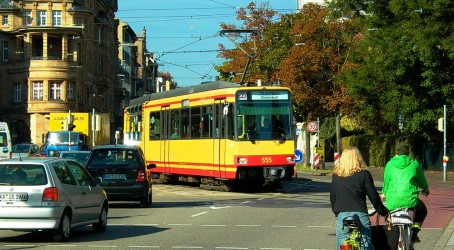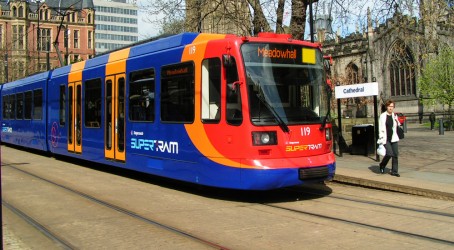Here are some interesting facts about Karlsruhe, a medium-sized city in the south-west of Germany. It has a very nice look-out tower that dates back to the 13th century. And it is the birthplace of Christa Bauch, who is a very famous female bodybuilder, apparently. Other than that, linking the word “interesting” with Karlsruhe is a little difficult – it’s a civilised but unremarkable kind of place.
But hold on a minute – if clean, efficient and wonderfully interconnected public transport is your specific area of interest, then Karlsruhe’s star suddenly shines very brightly. The city has pioneered the concept of the tram-train – a system where trams are designed to run seamlessly on both the tracks of a light-rail urban tramway network and on existing regional “heavy” railways. That means passengers can get right into the heart of the city from a spider’s web of far-flung places like the Black Forest without having to make any changes to their mode of transport. The Karlsruhe system is renowned for its flexibility and convenience and has been used as a blueprint for other tram-train developments across mainland Europe.
Now even the notoriously conservative UK transport sector is starting to seriously investigate the concept of tram-trains. Infrastructure provider Network Rail, train operator Northern Rail and tram operator Stagecoach have joined forces to construct a plan to run tram-trains between Sheffield and Rotherham on the current freight route from Rotherham and then joining the Sheffield Supertram network at the Meadowhall Interchange.
The partners claim that tram-trains are greener than conventional trains as they use less fuel. They also say they have faster acceleration and deceleration rates, which give passengers better journey times. They are also lighter, which may reduce wear and tear on tracks.
The Sheffield-Rotherham trial will assess the environmental benefits, operating costs and technical suitability of the tram-trains as well as testing how popular the vehicles are with passengers. If successful, the project could lead to more tram-trains operating throughout the UK.
According to Ian Ambrose, future rail development manager (light rail) at Network Rail, the Rotherham-to-Sheffield trial will play an important role in establishing the case for an expanded tram-train network. “One of the reasons for looking at tram-trains is to understand whether or not we need a more integrated transport system,” he says.
“Our pragmatic approach to new developments means there have been many light rail schemes in development for the past 20 years. In that time, Karlsruhe has expanded from 50km to over 500km. At Network Rail, we have a duty to look at whether or not this is an appropriate transport offer for the future in the UK. And so, whilst there might be a view that says ‘let’s just get on with it and do it’, the question is – where are the right places for tram-train? Manchester might be an obvious candidate, and so might be Birmingham, or indeed Cardiff, if we can get a tram line in there. But if we don’t start planning that now, we will be too late.”
In terms of the Rotherham-to-Sheffield trial, it is Northern Rail’s responsibility to procure the electrically powered vehicles, while Network Rail is investigating what works are necessary to safely accommodate the vehicles on the heavy rail network. Originally there was also a proposal for a tram-train trial on the Penistone Line between Sheffield and Huddersfield via Barnsley using diesel rolling stock, but that project was hindered by emissions regulations and has been postponed.
So far the partners have worked together to assess the cost of track, signalling and station alteration to facilitate tram-train, and have identified the standards that will need to be changed to enable operation of tram-train vehicles on the heavy rail network. For instance, platforms on the heavy rail network tend to be quite high and there would need to be some form of access modification to accommodate light rail vehicles. There has also been much work carried out into resolving issues around the wheel-rail interface.

Interchange of ideas
The depth of interest in tram-train systems was illustrated by a very well-attended conference on the subject that was held at the IMechE headquarters at the end of last month. The event was organised by the IMechE railway division in conjunction with Rail Research UK, the Railway Industry Association and the Engineering Integrity Society. For more information on forthcoming railway division events in areas such as asset management and fleet reliability, go to www.imeche.org/industries/railway.
But the project is still very much a work in progress, and there are numerous other interface issues such as signalling that need to be ironed out to enable the smooth transition of vehicles from light rail to heavy rail. Regulatory and legal issues are also being considered, as well as more practical considerations such as where fleet maintenance depots would be located.
And then there are operational considerations such as timetables and performance that have to be weighed up. Despite being given priority right of way, trams on Sheffield streets can get delayed by lorries or buses that have broken down in front of them. The project partners need to understand what impact such occurrences would have on the Network Rail infrastructure – and who would pay for the disruption.
Safety culture also comes into play, in that people in cities are quite used to trams running on tracks, and are comfortable manoeuvring around them. But Stuart Draper, engineering director at Northern Rail, worries that passengers will mistakenly attempt to transfer that kind of mindset to the heavy rail network. “Will passengers still believe they can wander around and do what they want?” he asks. “There are some significant issues in how the passenger changes his or her mindset from tramways into heavy rail. That will involve a lot of public education, but it will also mean barriers being erected in certain places. It’s a big consideration.”
Also key to the success of the project will be the cost-effective procurement of the electric tram-trains themselves. For that process, the partners have appointed Mott MacDonald to provide technical advice before a tender is issued for the vehicles, which will have capacity for 220 people. At one stage, a secondhand batch of Bombardier vehicles that had been used in a tram-train trial in the Netherlands were considered, but the 10% gradients on the Sheffield network would have meant costly modification to systems such as braking.
As a result, the rolling stock will be bought off the shelf, as long as it has sufficient compatibility with existing infrastructure – which means coping with factors such as 25m radius curves, 150mm track cant and cant gradients of 1 in 300.
There is also still some debate over the passenger environment. Trams traditionally have fewer seats and more standing room than heavy-duty rail vehicles, and they rarely have toilets. But, if passengers will be making journeys of up to an hour, then those factors may have to be reconsidered.
“It’s very much about what the customer wants,” says Draper. “Without the customer being interested and wanting to travel, tram-trains won’t be any use at all.”
The technical side of the project is moving forwards. But the green light won’t be given until the Department for Transport signs off funding for the next phase. In the current economic climate, there are fears that the go-ahead may be postponed or cancelled. But Draper prefers to be upbeat, and predicts that, with everything being equal, the tram-train could be introduced by the end of 2012.

Europe shows the way ahead
Karlsruhe is home to what is widely considered to be the best example of a tram-train system in the world. It has grown to more than 500km of track and boasts a very high level of passenger acceptance. It has contributed to a significant modal shift from road to rail and is credited with stimulating regional growth in surrounding areas.
“The system is a tram in the city and a train in the regions,” says Nils Jänig, head of transport, planning and rolling stock technology at TTK, a subsidiary of the Karlsruhe tram-train operator. “It’s a very dynamic case for the development of train-tram. The network is not finished – we are still dealing with new projects.”
The success of Karlsruhe has prompted other German towns and cities to embrace tram-train technology. These include the formation of a tram-train network in Saarbrücken on the French-German border, which was opened in 1997, and a network in the town of Kassel in central Germany, which opened in 2006.
France is also getting in on the act, with a tram-train system constructed in Mulhouse in the eastern part of the country and plans to build networks in Lyons and Strasbourg. The dominance of SNCF as the single nationally owned train operator in France means that its tram-train systems have been conceived and built in relatively short periods, without the endless debate that seems to dog infrastructure projects in other countries.
Indeed, Jänig feels that the fragmented nature of the UK rail network means that the adoption of the technology in this country will be very slow. And he fears that, when it does start to happen, there will be too much focus on the development of bespoke technologies. “Take what others have already done and do not try to reinvent the wheel,” he says. “You do not need a UK tram-train – you need a European tram-train.”